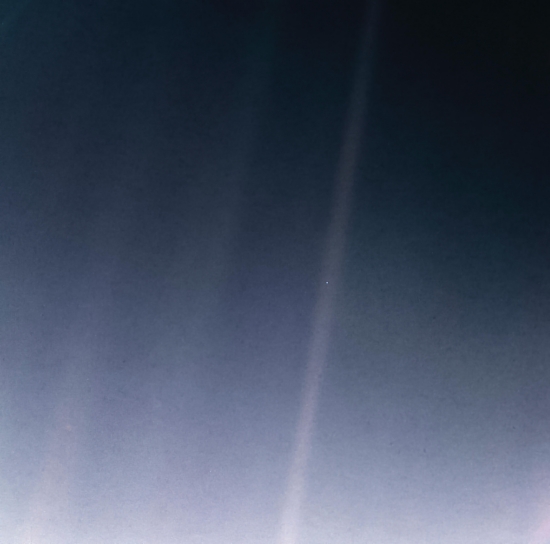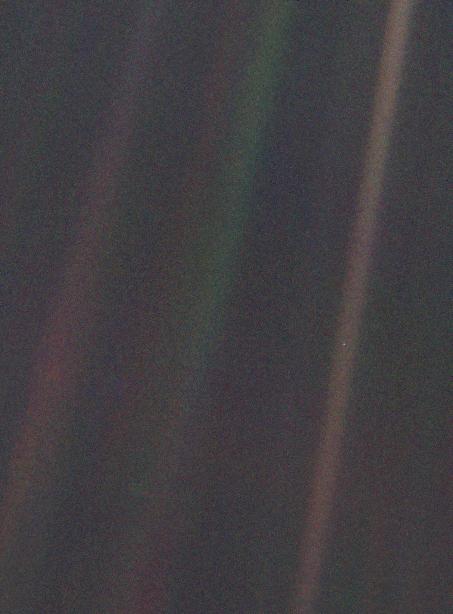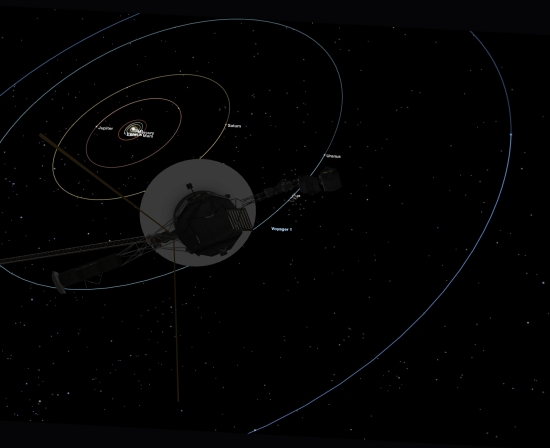The 30th anniversary of the famous ‘Pale Blue Dot’ image of Earth, which took place on February 14, is an appropriate occasion for the newly updated image below, which brings the latest methods to bear on the data Voyager 1 presented us. Our planet takes up less than a single pixel and for that reason is not fully resolved. The rays of sunlight due to scattering within the camera optics intersect with Earth, reminding us that from Voyager’s position 6 billion kilometers from home, the Earth/Sun separation was only a matter of a few degrees.

Image: For the 30th anniversary of one of the most iconic images taken by NASA’s Voyager mission, a new version of the image known as “the Pale Blue Dot.” Planet Earth is visible as a bright speck within the sunbeam just right of center and appears softly blue, as in the original version published in 1990. This updated version uses modern image-processing software and techniques to revisit the well-known Voyager view while attempting to respect the original data and intent of those who planned the images. Credit: NASA/JPL-Caltech.
What we’re looking at is a color composite that combines images taken through green, blue, and violet spectral filters with the Voyager 1 Narrow-Angle Camera. 34 minutes after this work was done, Voyager 1 powered off its cameras, there being no targets for future flybys. In any case, controllers needed to conserve power for what would become the Voyager Interstellar Mission, an undertaking that is still alive. The image also reminds us that images of the inner planets would have been dangerous if taken earlier in the mission, given the possibility of damaging the cameras due to their proximity to the Sun.
And here is the original, with JPL caption from 1996:

Image: This narrow-angle color image of the Earth, dubbed ‘Pale Blue Dot’, is a part of the first ever ‘portrait’ of the solar system taken by Voyager 1. The spacecraft acquired a total of 60 frames for a mosaic of the solar system from a distance of more than 4 billion miles from Earth and about 32 degrees above the ecliptic. From Voyager’s great distance Earth is a mere point of light, less than the size of a picture element even in the narrow-angle camera. Earth was a crescent only 0.12 pixel in size. Coincidentally, Earth lies right in the center of one of the scattered light rays resulting from taking the image so close to the sun. This blown-up image of the Earth was taken through three color filters — violet, blue and green — and recombined to produce the color image. The background features in the image are artifacts resulting from the magnification. Credit: NASA/JPL.
A series of 60 images went into making what the mission team called a Family Portrait of the Solar System, a sequence that captured six planets as well as the Sun. For readers of Centauri Dreams, I doubt I have to wax poetic here, as most of you have your own thoughts, remembering the first time you saw this breathtaking image and tried to fit it into your own perspective on the cosmos. It was Carl Sagan who came up with the idea for the image, and it’s fitting that the Carl Sagan Institute’s Lisa Kaltenegger (Cornell) should comment on it;
“The Pale Blue Dot image shows our world as both breathtakingly beautiful and fragile, urging us to take care of our home. We are living in an amazing time, where for the first time ever we have the technical means to spot worlds orbiting other stars. Could one of them be another pale blue dot, harboring life? That is what we are trying to find out at the Carl Sagan Institute.”

Image: This simulated view, made using NASA’s Eyes on the Solar System app, approximates Voyager 1’s perspective when it took its final series of images known as the “Family Portrait of the Solar System,” including the “Pale Blue Dot” image. Credit; NASA/JPL-Caltech.
Ed Stone, Voyager project scientist, called this final use of the spacecraft’s lenses ‘last light,’ in contrast to the initial imaging by a telescope, which is known in the trade as ‘first light.’ It’s remarkable to consider today that at the time, the idea of Voyager’s look back at the Solar System was dismissed by some as a stunt, and it’s worth remembering that there were those in the Voyager design days who advocated that the spacecraft carry no cameras at all.
Jim Bell writes about the matter in his book The Interstellar Age:
Fortunately, after the Neptune encounter, top NASA officials such as associate administrator for science Len Fisk and administrator Richard Truly shared Carl Sagan’s vision of the historic, aesthetic value of the solar-system family portrait. Ed Stone was also a strong supporter of the idea. He recalls a dinner at Caltech organized by Sagan and The Planetary Society just before the Voyager Neptune flyby in 1989, during which he, Sagan, Fisk, and Voyager project manager Norm Haynes talked about what it would take to make ‘the picture of the century’ happen. By this point in time it was essentially a budgetary issue, as Voyager’s funding was set to ramp down steeply right after Neptune. Happily, Fisk and Truly interceded to make sure the people and resources were made available for this one last Voyager mosaic…
We might not have had the ‘pale blue dot’ image at all if it had not been for this intervention, a reminder of the significance of decisions that at the time may seem small once examined in the context of history. It’s only right to quote Sagan’s famous words on the image to close, from his book Pale Blue Dot: A Vision of the Human Future in Space (1994):
“Look again at that dot. That’s here. That’s home. That’s us. On it, everyone you love, everyone you know, everyone you ever heard of, every human being who ever was, lived out their lives. The aggregate of our joy and suffering, thousands of confident religions, ideologies and economic doctrines, every hunter and forager, every hero and coward, every creator and destroyer of civilization, every king and peasant, every young couple in love, every mother and father, hopeful child, inventor and explorer, every teacher of morals, every corrupt politician, every ‘superstar,’ every ‘supreme leader,’ every saint and sinner in the history of our species lived there – on a mote of dust, suspended in a sunbeam.”



What a very good man he was — and what a message we need now as much as ever!
I wonder if you could notice a difference in the color of the Pale Blue Dot today due to the loss of Arctic pack ice.
Sagan was best at giving us a cosmic perspective of our planet!
We need to send some flat earth devotees up and not let them come back to earth till they admit that it is round!
Space Adventures to fly tourists on Crew Dragon mission.
https://spacenews.com/space-adventures-to-fly-tourists-on-crew-dragon-mission/
A new threat to Earth and traveling in space by Harvard astronomers Amir Siraj and Prof. Abraham Loeb.
There Could be Meteors Traveling at Close to the Speed of Light When They Hit the Atmosphere.
https://www.universetoday.com/145006/there-could-be-meteors-traveling-at-close-to-the-speed-of-light-when-they-hit-the-atmosphere/